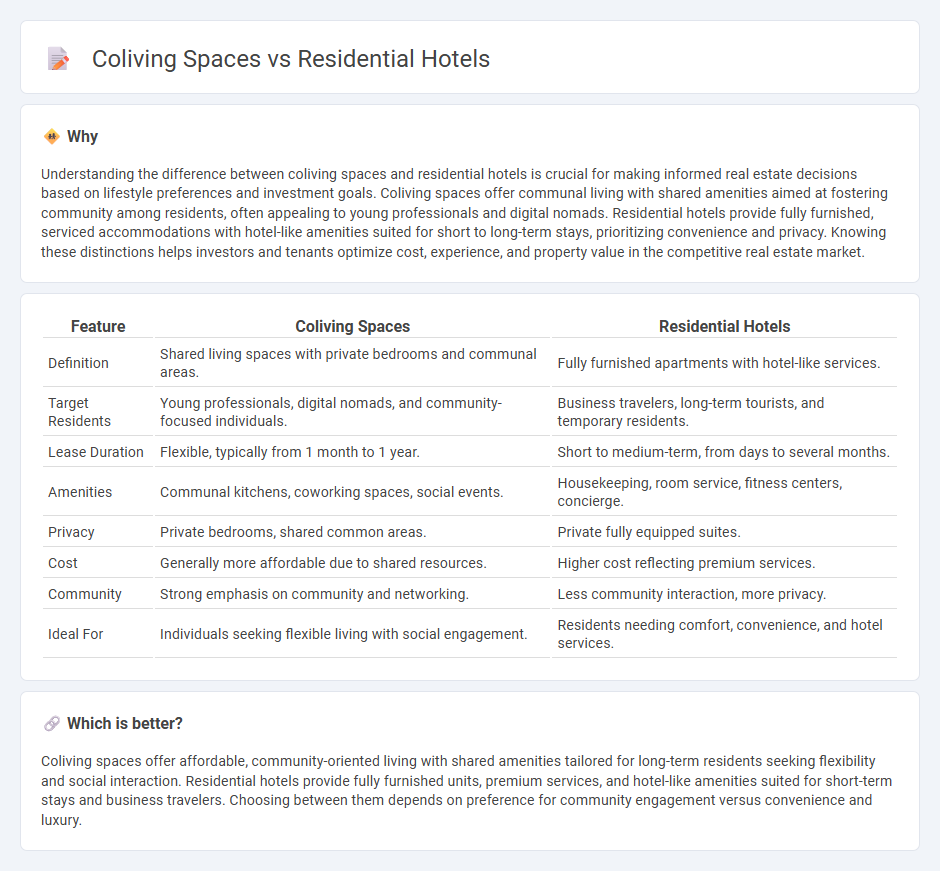
Coliving spaces offer affordable, community-focused living with shared amenities and flexible lease terms, appealing to young professionals and digital nomads. Residential hotels provide fully furnished apartments with hotel-style services, catering to business travelers and long-term guests seeking convenience and comfort. Explore the benefits and differences to determine which living option suits your lifestyle best.
Why it is important
Understanding the difference between coliving spaces and residential hotels is crucial for making informed real estate decisions based on lifestyle preferences and investment goals. Coliving spaces offer communal living with shared amenities aimed at fostering community among residents, often appealing to young professionals and digital nomads. Residential hotels provide fully furnished, serviced accommodations with hotel-like amenities suited for short to long-term stays, prioritizing convenience and privacy. Knowing these distinctions helps investors and tenants optimize cost, experience, and property value in the competitive real estate market.
Comparison Table
| Feature | Coliving Spaces | Residential Hotels |
|---|---|---|
| Definition | Shared living spaces with private bedrooms and communal areas. | Fully furnished apartments with hotel-like services. |
| Target Residents | Young professionals, digital nomads, and community-focused individuals. | Business travelers, long-term tourists, and temporary residents. |
| Lease Duration | Flexible, typically from 1 month to 1 year. | Short to medium-term, from days to several months. |
| Amenities | Communal kitchens, coworking spaces, social events. | Housekeeping, room service, fitness centers, concierge. |
| Privacy | Private bedrooms, shared common areas. | Private fully equipped suites. |
| Cost | Generally more affordable due to shared resources. | Higher cost reflecting premium services. |
| Community | Strong emphasis on community and networking. | Less community interaction, more privacy. |
| Ideal For | Individuals seeking flexible living with social engagement. | Residents needing comfort, convenience, and hotel services. |
Which is better?
Coliving spaces offer affordable, community-oriented living with shared amenities tailored for long-term residents seeking flexibility and social interaction. Residential hotels provide fully furnished units, premium services, and hotel-like amenities suited for short-term stays and business travelers. Choosing between them depends on preference for community engagement versus convenience and luxury.
Connection
Coliving spaces and residential hotels both cater to urban dwellers seeking flexible, community-oriented housing solutions with fully furnished amenities and shared common areas. They optimize real estate utilization by offering shorter lease terms and fostering social interactions among residents, appealing to young professionals and digital nomads. These models reflect evolving real estate trends emphasizing convenience, affordability, and lifestyle integration in high-demand metropolitan markets.
Key Terms
Lease Structure
Residential hotels typically offer flexible short-term leases with daily or monthly billing, catering to travelers and temporary residents seeking convenience and services. Coliving spaces generally provide longer lease terms, often spanning six to twelve months, with shared amenities and community-focused living arrangements designed for young professionals or digital nomads. Explore the detailed lease structures and benefits of both options to determine which suits your lifestyle and housing needs best.
Amenities
Residential hotels typically offer extensive amenities such as 24/7 concierge services, housekeeping, fitness centers, and on-site dining options, catering to long-term guests seeking hotel-like comfort. Coliving spaces emphasize shared amenities like communal kitchens, coworking areas, and social events designed to foster community and collaboration among residents. Explore more details on how amenities differentiate residential hotels and coliving spaces to find the best fit for your lifestyle.
Occupancy Duration
Residential hotels typically offer short to medium-term stays ranging from a few weeks to a few months, catering to business travelers and temporary residents seeking flexible accommodations. Coliving spaces emphasize longer occupancy durations, often spanning several months to a year, attracting individuals looking for community-driven living with shared amenities and social engagement. Explore the evolving trends in occupancy duration to determine the best fit for your lifestyle or investment goals.
Source and External Links
Apartment hotel - Residential hotels, also known as apartment hotels or extended-stay hotels, are serviced apartment complexes with hotel-style bookings, offering amenities like kitchens and living spaces for longer stays, popular in chains such as Residence Inn, Staybridge Suites, and Extended Stay Hotels.
Long Term Stay Hotels - stayAPT Suites - StayAPT Suites exemplifies residential hotels by providing suites with full kitchens, living rooms, separate bedrooms, and flexible nightly, weekly, and monthly rates designed for long-term comfort.
Staybridge Suites(r) Hotels | Extended Stay Hotels - Staybridge Suites offers extended stay hotel options with residential-style suites, complimentary breakfast, communal amenities, and services aimed at balancing work, family, and comfort during extended travel.
 dowidth.com
dowidth.com